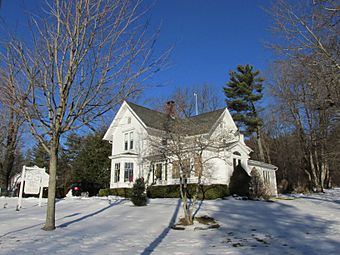South Egremont Village Historic District facts for kids
Quick facts for kids |
|
|
South Egremont Village Historic District
|
|

John O'Neil House, c 1880
|
|
| Location | South Egremont, Massachusetts |
|---|---|
| Area | 375 acres (152 ha) |
| Architectural style | Greek Revival, Late Victorian |
| NRHP reference No. | 84002086 |
| Added to NRHP | May 31, 1984 |
The South Egremont Village Historic District is a special area in South Egremont, Massachusetts. It includes most of the village, which looks much like it did in the 1840s. This historic village is found along Massachusetts Route 23, near the Taconic Mountains. It was added to the National Register of Historic Places in 1984, recognizing its importance.
Contents
Discovering South Egremont's Past
South Egremont was first settled in the late 1730s. It officially became a town in 1761. This village started as a farming community. Karner Brook provided water power for a sawmill as early as 1780.
How a Road Changed the Village
A big change happened in 1801. The state of Massachusetts built a turnpike through the area. A turnpike was a main road where people paid a fee to use it. This road is now Massachusetts Route 23. It helped the village grow as a place for travelers to stop. Small businesses also started up. They made things like shoes and parts for carriages near Karner Brook.
Important Buildings and Places
Many old buildings in the district tell stories of the past. The Mt. Everett Academy opened in 1832. It was the town's first high school. Its building is a great example of Greek Revival style. Later, it also served as the town hall and library.
Other important spots include:
- The Egremont Village Inn, built in 1780. It was moved in 1801 to be closer to the new turnpike.
- The Congregational Church, built in 1832-1833. Its old horse sheds, where people left their horses, are still there.
- The South Egremont Store, which opened in 1825.
- The South Egremont Village School, built in 1880. This was one of the last one-room schoolhouses in the United States to stay open for a long time.
A Village Preserved in Time
The village was doing well in the late 1800s. But in the early 1900s, its economy slowed down. Things changed again in the 1930s. A person named Hugh Smiley helped bring tourists to the area. He started "Olde Egremont" to help keep the village looking like it did in the mid-1800s.
Today, the historic district follows Massachusetts Route 23. It stretches from its meeting point with Massachusetts Route 41 in the west to Sheffield-Egremont Road in the east. A map from 1844 showed 55 buildings. Amazingly, 44 of those buildings are still standing today! Only five new buildings have been added since then. This shows how well the village has kept its historic look.



